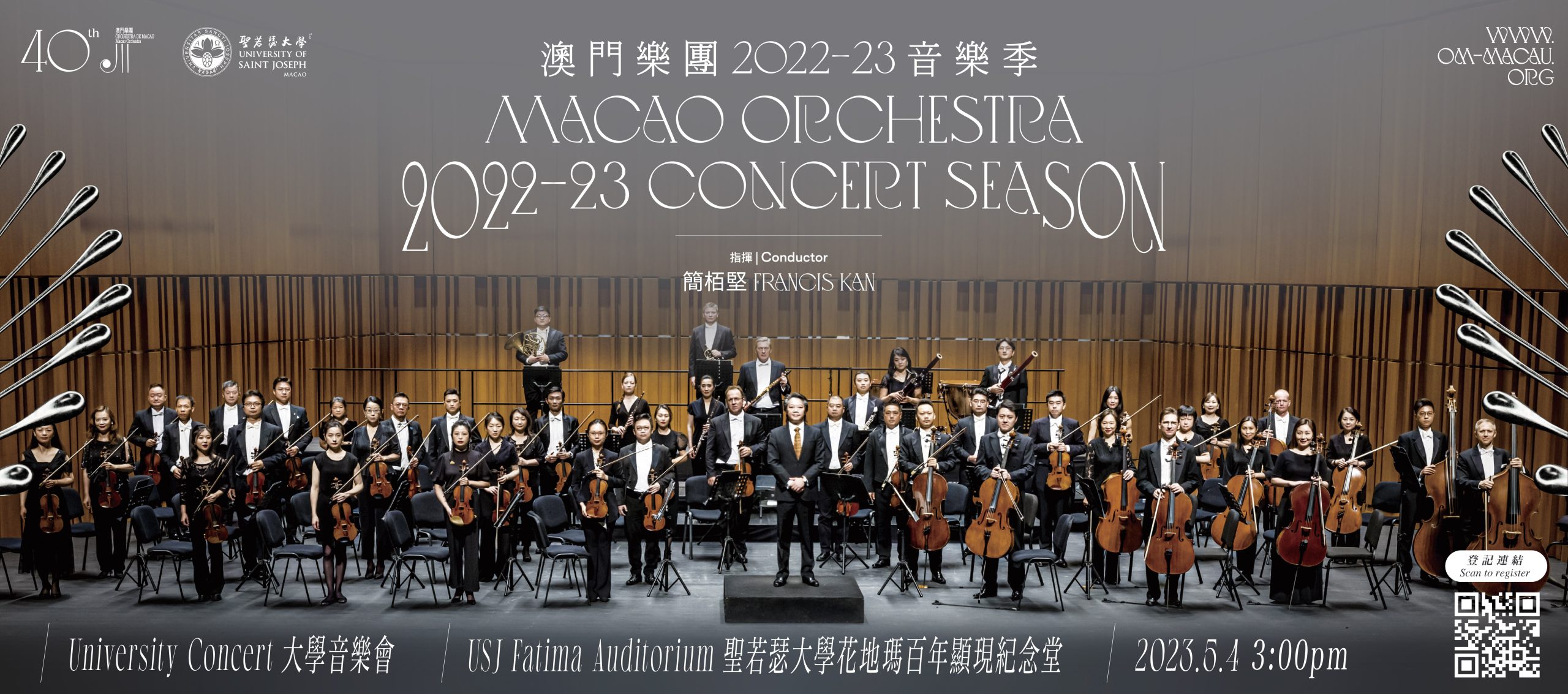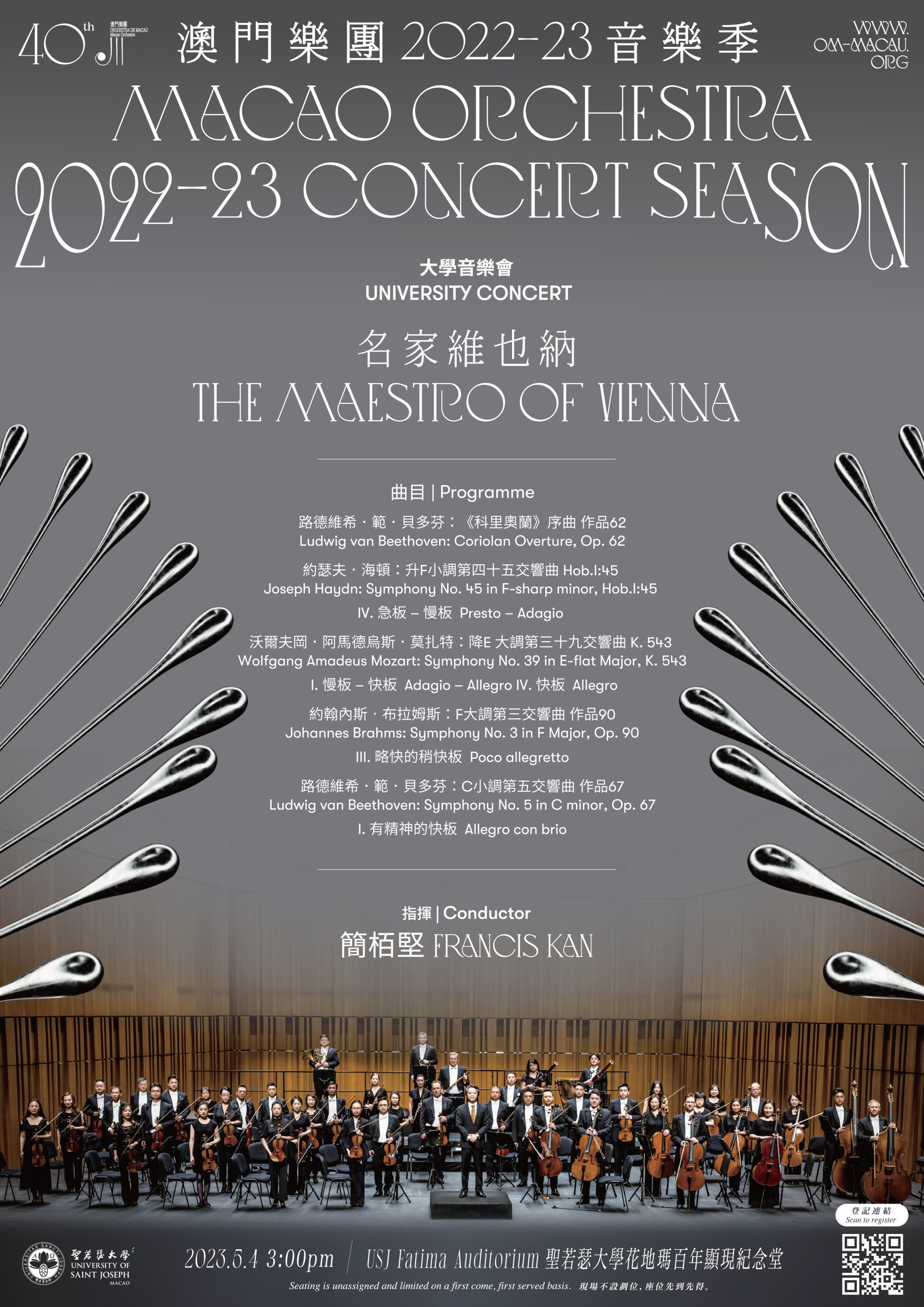Macao Orchestra 2022-23 Concert Season: The Maestro of Vienna

Macao Orchestra 2022-23 Concert Season: The Maestro of Vienna
04
May
The “Macao Orchestra 2022-23 Concert Season: The Maestro of Vienna” will be held on Thursday, 4 May, at Auditório Centenário de Fátima.
DETAILS:
Date: Thursday, 4 May 2023
Time: 15:00 – 16:15 *
Location: Auditório Centenário de Fátima, University of Saint Joseph
* Reception starts at 2:30pm
* Seating is limited and on a first come, first served basis (free seating)
PROGRAMME:
1. Ludwig van Beethoven: Coriolan Overture, Op. 62
The Coriolan Overture is an 1807 composition by German composer Beethoven (1770-1827), based on the tragedy Coriolan by dramatist Heinrich Joseph von Collin (1771-1811). At the time of writing, Beethoven had pulled through his Heiligenstadt crisis, entering a mature and productive period of artistic creation.Colin’s drama was inspired by the tragic story of the legendary Roman general Gaius Marcius Coriolanus. The Overture, in the key of C minor, is of special meaning to Beethoven and adopts the sonata form. At the same time, there is a certain narrative thread in the processing of thematic image and structure, to follow the theme of the play generally. The Coriolan Overture begins with a dramatically powerful chord, and the melancholic, anxious main theme is in stark contrast to the soothing, tender, second theme in E-flat major. The former represents Coriolanus’ roughness and belligerent restlessness, while the latter represents his mother’s persistent pleadings. In the short transition section, the insistent, iterative patterns and continuous modal progression reveal the protagonist’s inner struggles mixed with ambivalence and hesitation. The recapitulation leads straight to the extremely tragic ending. The powerful chord reappears, but the originally fierce vigour gradually fades away, with the main theme representing Coriolanus blunting its original edges more and more. As the durations prolong and the intensity weakens, it dissolves into a deep sigh. The weak strings at the end symbolize the demise of Coriolanus.
2. Joseph Haydn: Symphony No. 45 in F-sharp minor, Hob.I:45
IV. Presto – Adagio
Joseph Haydn (1732-1809) is well known as a highly skilled and prolific composer who made a great contribution to symphonic composition. Born in Austria in 1732, Haydn wrote more than 100 symphonies, thus being fondly referred to as the “Father of the Symphony” for his vast body of work. From 1761 Haydn had been employed by the famed, influential Esterházy family in Hungary. This symphony was one of the works written by the composer during his years in the service of the Esterházys. Completed in 1772 and titled “Farewell” from the crafted design in the fourth movement, the Symphony No. 45 is filled with the character of Sturm und Drang (“storm and stress”) – dark drama and turbulence, a movement of the late 18th century in German literature and music that exalted emotionalism.
As the composer himself recalled, the Esterházy family spent their summers at the Summer Palace every year, and of course the music-loving Prince Esterházy asked the musicians he hired to come along. But they could not bring their families and had to remain apart from their wives and children during that period.
In Classical tradition, the symphony should end at the presto section. Yet, going against the trend of the time, Haydn inserted an adagio after the presto. To open the adagio section, the whole orchestra plays the theme of reluctant farewell. As the musical texture gradually eased, the idle performers started leaving the stage, one by one, as the music faded towards the end. Taking note of Haydn’s hint, the next day Prince Esterházy decided to return to the Esterházy Palace, so the musicians could finally bid “farewell” to their months-long lonely life.
3. Wolfgang Amadeus Mozart: Symphony No. 39 in E-flat Major, K. 543
I. Adagio – Allegro
IV. Allegro
Wolfgang Amadeus Mozart (1756-1791) epitomized the Classical symphony in the 18th century. Of the 41 symphonies he wrote, the last six written in the 1780s are widely regarded as great works reflecting his mature style, with unparalleled emotional depth, built-in drama, complex structure, and rich expressivity.
Symphony No. 39 is the only symphony in Mozart’s adulthood that does not use oboes, instead giving the clarinets unusual prominence. The first movement (in sonata format) begins with a slow intro – an approach often taken by Haydn but rare in Mozart symphonies – thus opening the whole work solemnly, with its heavy tone and vague tonality paving a contrasting way for the following bright, brisk allegro. The nimble, light fourth movement shows the influence of Haydn’s humorous and mono-thematic approach.
4. Johannes Brahms: Symphony No. 3 in F Major, Op. 90
III. Poco al
Johannes Brahms (1833-1897) wrote four symphonies in total. Though not a prolific symphony composer, he boasts symphonic masterpieces that are extremely complex. His Symphony No. 3 was written in 1883 and premiered by the Vienna Philharmonic Orchestra the same year. Known at the time as Brahms’ “Eroica”, the four-movement Third Symphony is the shortest of his symphonies, with each movement in roughly the same size and equal proportion.
The third movement, instead of being a usual scherzo, is a highly lyrical, midtempo movement, written in ternary form. The passionate yet sad main theme played by strings, is typically romantic. The middle part is mainly played by woodwinds. Its rhythm and tone are a bit lively, contrasting with the previous long-drawn aria. The theme in the recapitulation section is first handled by the horn(s) and oboe(s). A somber tone of emotional temperature fills the atmosphere throughout the movement.
4. Ludwig van Beethoven: Symphony No. 5 in C minor, Op. 67
I. Allegro con brio
Among the nine symphonies of German classical master Beethoven (1770-1827), Symphony No. 5 in C minor, known as “Destiny”, is probably the best known. Beethoven struggled throughout his life with the increased hearing loss. It was on the brink of despair that he wrote the Heiligenstadt Testament in 1802, but he finally overcame this fatal psychological blow with extraordinary will power and determination to fulfil his art. The Fifth Symphony is the perfect embodiment of Beethoven’s heroic spirit, “taking fate by the throat”. The work was written between 1804 and 1808 and first performed at Vienna’s Theater an der Wien on December 22, 1808. The piece consists of four movements. The first movement begins with what is known as “fate’s motive”, often described as “fate knocking at the door”, which serves to thread the part together throughout. The first theme represented by this motive is passionate and powerful, with an unstoppable impetus. Then with the horn fanfare playing the variations of the fate’s motive, the music shifts into the lyrical, bright second theme.
ABOUT THE MACAO ORCHESTRA:
The Macao Orchestra (OM) is a professional ensemble under the auspices of the Cultural Affairs Bureau of the Macao S.A.R. Government. OM is now a distinguished orchestra of Asia, performing Chinese and Western classics throughout the times. It has also played a key role in the music and cultural life of Macao residents and overseas audiences.
In 1983, Father Áureo de Castro of the St. Pious X Academy of Music and a group of music lovers founded the Macao Chamber Orchestra. In 2001, the Macao Chamber Orchestra was extended into an orchestra with double winds; it was renamed the Macao Orchestra. Today, it has developed into a medium-sized orchestra of around 50 outstanding musicians from more than ten countries and regions. In 2008, Maestro Lu Jia commenced his tenure as Music Director and Principal Conductor of the Orchestra, initiating the convention of “Concert Seasons” and in each season 90 different concerts and outreach programme would be held, presenting to the public, comprehensively and systematically, classics from both Western and Chinese.
The Orchestra collaborates regularly with numerous internationally renowned musicians, conductors and ensembles. In addition, OM has regularly been invited to perform in Mainland China and overseas, participating in the 2015 Austria Bruckner Festival as China’s representative and attending the music festival “La Folle Journee au Japon” in Japan 2016. In 2017 and 2019, the Orchestra also participated in the “Belt and Road” International Music Season in Shenzhen. In celebrating the 40th Anniversary of the Establishment of Diplomatic Relations between China and Portugal and the 20th Anniversary of Macao’s Return to the Motherland, OM made a Portugal tour in 2019, and in December of the same year, the Orchestra performed in the gala performance which celebrated the 20th anniversary of Macao’s return to the motherland.










